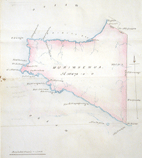Tainui
Tainui, the central North Island region of Aotearoa/New Zealand.

Peeke o Aotearoa: Blank Bank Cheque. Printed in Maori by the Maori King Movement, 1860s. Misc-MS-1535-1/5, Hocken Library.
The King Movement leaders believed that the Treaty's guarantee of Rangatiratanga (Chiefly authority) confirmed that a relationship of equality would continue allowing Maori people a degree of autonomy and independence. One symbol of Maori independence is this bank cheque printed in Maori by the King Movement during the 1860s.

Letter from Matene te Whiwhi, Otaki, 19 November 1863. Shortland Papers, MS 0385/002, Hocken Library.
Once the art of writing was mastered, Maori became prolific correspondents writing to each other and to the Colonial Government. These letters were often used to express anger and frustration at the policies that were being instigated by the new governing powers, especially those that bought about the loss of ancestral lands. This is a letter written by Matene Te Whiwhi to Edward Shortland, 10 November 1863. Te Whiwhi's letter is a narration of events informing Shortland of the meetings he has attended with other influential Maori leaders in the Otaki and Wellington region to discuss land issues.

Letter from Wiremu Tamihana Tarapipipi Te Waharoa to Edward Shortland, 1 May 1866. Shortland Papers, MS 599/ Part 1, Hocken Library.
Sir James Hector (1834 - 1907) was a geologist and explorer, and from 1865 was appointed director of the Geological Survey and Colonial Museum in Wellington. He made extensive explorations and geological surveys of both the North and South islands. These two journals contain notes and sketches from expeditions in the Northland district in 1866 and 1874. The name Rawhiti appears on the above sketch. Unfortunately no names appear in the journal notes for the sketch below.

Map of Muriwhenua, n.d. Shortland papers, MS-489/1, Hocken Library.
The name Muriwhenua was recorded in 1793, possibly for the first time by Tuki Tahua, after he was kidnapped and taken to Norfolk Island. The Maori spiritual pathway ends in Muriwhenua at Te Rerenga Wairua (Cape Reinga). The tribes of Muriwhenua see themselves as guardians of this pathway, where all departed souls of Maori must travel to reach their spiritual homeland.


